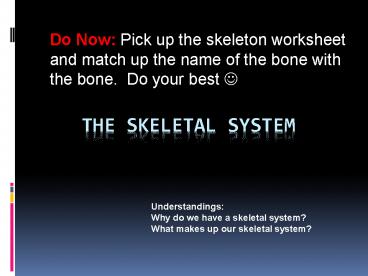The Skeletal system PowerPoint PPT Presentation
1 / 24
Title: The Skeletal system
1
The Skeletal system
Do Now Pick up the skeleton worksheet and match
up the name of the bone with the bone. Do your
best ?
Understandings Why do we have a skeletal
system? What makes up our skeletal system?
2
Objective
- Label the parts of the skeletal system
- Explain how the skeletal system functions
- Identify problems with the skeletal system
- Recall how to care for your skeletal system
3
Skeletal System
- Body System a group of organs that work together
to perform an important function - Skeletal System a frame work of bones that
supports you, allows you to move, protects vital
organs and produces blood cells - Functions
- Supports you
- Allows you to move
- Protects vital organs
- Produces blood cells
4
The Skeletal System
- Made up of 206 bones.
- The bones of the face, skull, vertebral column
and rib cage make up your bodys central
framework for support. (Protects vital organs!)
5
Important Bone Terms
- Cartilage a strong flexible tissue on the ends
of some bones - It provides a cushion where bones come together.
- Ligaments strong cords of tissue that connect
bones to bones in your joints.
6
Support and Movement
- Which bones provide support and movement?
- Bones of the
- Arms
- Legs
- Pelvis
- They work with muscles to help us move!
7
Anatomy of a Bone
- The Inside of a Long Bone
- Parts of a Long Bone
- Periosteum covering on bones
- Compact Bone hard bone
- Spongy Bone soft bone
- Bone Marrow blood cells made here
- Parts of the Bone
8
Movie The Skeletal System
9
How do our bones move?
- Joint a point at which two bones meet.
- Without joints, you could not move.
- Three main kinds of joints
- Hinge Joint
- Ball and Socket Joint
- Fixed Joint
Muscle and Bones Make Joints Move
10
Joints
Types of Joints Movements Locations
Hinge Joint Provides back and forth movement. Elbow, Knees
Fixed Joint No movement is allowed. Plates of the skull
Ball-and-Socket Joint Allows a wide range of movements. Shoulder, Hip
11
The Skeletal System
- Skull
- Clavicle
- Scapula
- Humerus
- Sternum
- Rib Cage
- Vertebrae
- Ulna
- Radius
- Femur
- Patella
- Fibula
- Tibia
12
(No Transcript)
13
(No Transcript)
14
(No Transcript)
15
(No Transcript)
16
(No Transcript)
17
The X-Ray GIFs of Cameron Drake
- Moving X-rays
18
Brain Pop Videos
- Joints
- Broken Bones
19
Problems and Caring for the Skeletal System
20
Skeletal System Problems
- Osteoporosis
- Osteoporosis Fact!
- A disease in which bones become thin and brittle.
- Who does this affect?
- 55 of people who are over the age of 55.
- Of the 10 million Americans who have this
disease, 8 million are women and 2 million are
men. - (from http//www.nof.org/osteoporosis/diseasefacts
.htm)
- About 85-90 of adult bone mass is acquired by
age 18 in girls and 20 in boys. Building strong
bones during childhood and adolescence can help
to prevent osteoporosis later in life. - (from http//www.nof.org/osteoporosis/diseasefacts
.htm)
21
Skeletal System Problems
- Scoliosis
- Photograph of someone with scoliosis.
- Causes deformity of the spine win which the
spine develops an S-shaped curve when viewed from
behind. - Can this affect you? Affects 2 of women and .5
of men in the general population
22
Skeletal System Problems
- Sprain
- What happens when you sprain your ankle?
- Stretching or partial tearing of ligaments.
- Can be painful and cause swelling around the
injured joint. - http//yucky.discovery.com/flash/body/yuckystuff/a
nklesprain/js.index.html
23
Caring for your Skeletal System
- Exercise regularly using weights, walking,
running, jumping rope, dancing, hiking, soccer,
or basketball (just to name a few activities!). - Wear proper fitting shoes.
- Select foods and beverages rich in calcium,
phosphorus, and vitamin D. - Sit, stand, and walk with correct posture.
- Participate in screenings for scoliosis.
24
Skeleton Game
- Labeling the Skeleton

